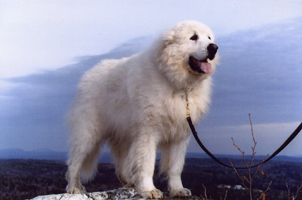History of the Breed
It is believed that ancestors of these large white livestock guardians migrated with shepherds from Asia about 5000 years ago. Perhaps most of the white large livestock guardian dogs are related by their Asian past and each of these breeds has been developed in various countries with slightly differing characteristics. Examples include the Marema, Kuvaz and AkBash.
 Today, the Great Pyrenees remain the most popular livestock guardian for sheep, goats, llamas and free ranging poultry throughout the Northeastern United States.
Today, the Great Pyrenees remain the most popular livestock guardian for sheep, goats, llamas and free ranging poultry throughout the Northeastern United States.
In the 12th Century, the French Royalty discovered these dignified dogs and the Great Pyrenees accompanied Royal French Guards to guard chateaux. In the 1700’s the Great Pyrenees were also companions to French nobility, as well as being pasture guardians and farm protectors.
In 1824 the first Great Pyrenees was brought to the United States by General Layfayette as a gift to a friend. He wrote to his friend, “From personal experience these dogs are of inestimable value to wool growers in all regions exposed to depredations of wolves and sheep-killing dogs.” During WWI, Great Pyrs were known to pack supplies for troops across the Pyrenees Borders of France and Spain.
The American Kennel Club recognized the bred in 1933 and the breed is recognized 44th of 145 recognized breeds. There is a reason they are NOT in the top 10 most popular dogs! Please keep reading!
Important to the history of Great Pyrenees was being brought to the United States from France, carefully bred and developed in the 1950’s by Mary Crane and other interested reputable breeders.
